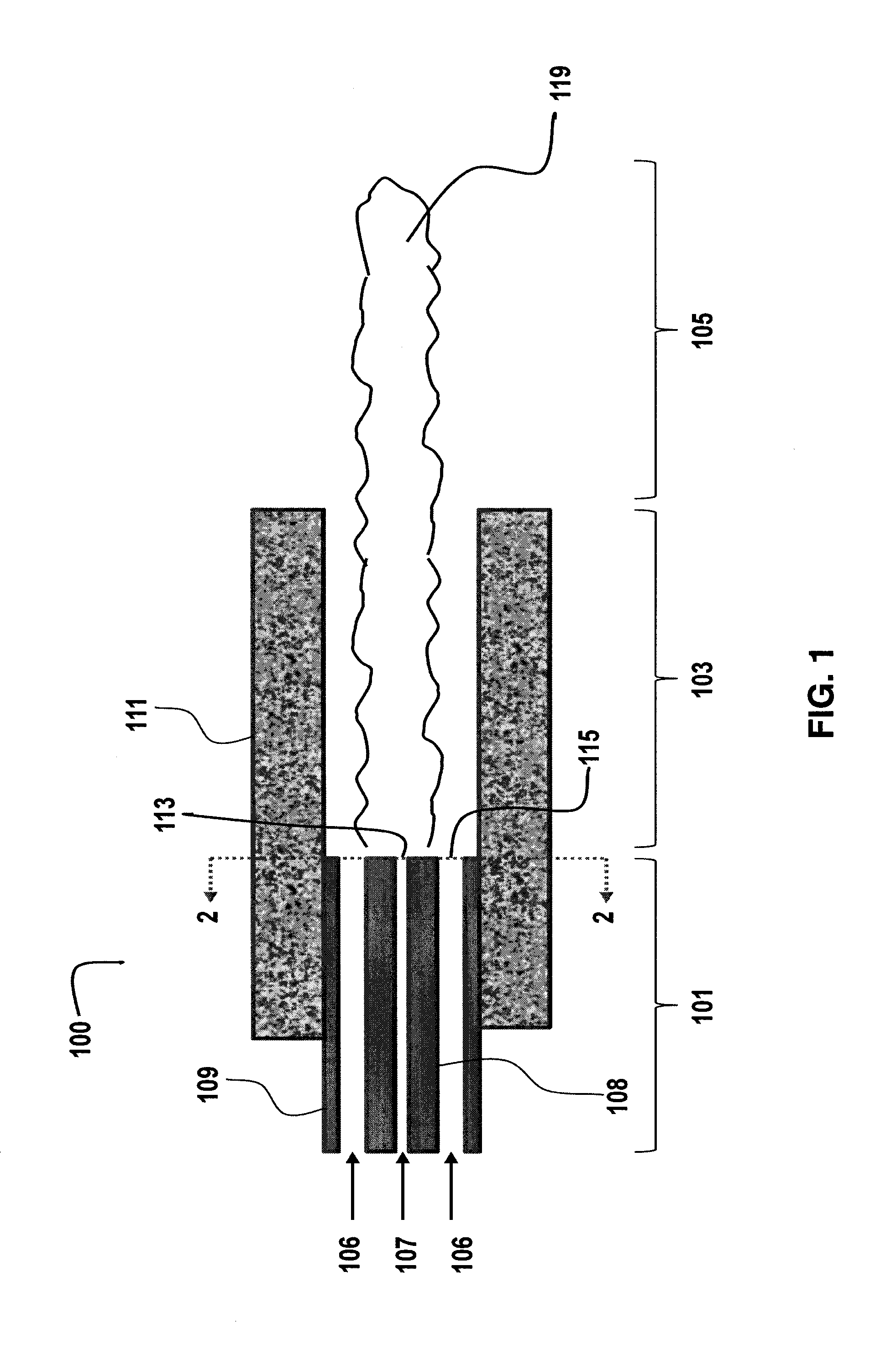Oxy-fuel burner arrangement
a burner arrangement and burner technology, applied in the field of burners, can solve the problems of glass contamination or volatilization of the high boiling components of glass, difficult identification of nozzle clogging problems, and glass quality problems,
- Summary
- Abstract
- Description
- Claims
- Application Information
AI Technical Summary
Benefits of technology
Problems solved by technology
Method used
Image
Examples
example 1
[0063]This Example evaluates the effect of fuel nozzle aperture geometry on the flame produced from the burner assembly in FIG. 1 with a cylindrical precombustor using fuel nozzle apertures shown in FIGS. 6-11. The burner was fired while equipped with each of the fuel nozzle apertures in a single burner test mode at a firing rate of 20,000 Btu / h in a refractory lined box. The burner tests of this example used a cylindrical precombustor length / diameter (L / D) of 6. The results of the evaluation are shown below in Table 1.
[0064]
TABLE 1Visible Flame LengthFuel velocity / Fuel NozzleCompared with CircleOxygenApertureAspect RatioNozzlevelocityCircle1.0—3.9Square1.0Unchanged8.1Cross1.0Unchanged8.1Clover1.07Unchanged8.1Snowman1.8Unchanged8.1Slot3.0Shortened8.1Two Half Circles4.17Shortened6.4
[0065]The results of these single burner firing tests show that changing the fuel nozzle aperture geometry has no effect on the flames produced by this burner if the aperture has an aspect ratio of 1.8 or ...
example 2
[0066]Example 2 is an evaluation of flame characteristics for a burner firing with a Circle (symmetric) and a burner firing with a Slot (non-circular) fuel nozzles aperture (shown in FIGS. 6-7), in single and multiple burner configurations in a refractory lined box. The cylindrical precombustor L / D for these tests was 6. Visible flame lengths are given in Table 2 (below). The visible flame lengths for both fuel nozzle aperture geometries shortened when the burners were fired in a multiple burner configuration as compared with a single burner configuration. The non-circular nozzle aperture geometry produced a shorter flame than the symmetric nozzle aperture geometry in both the single and the multiple burner firing configurations. Two different firing rates were tested in the multiple burner configuration. The non-circular nozzle aperture geometry produced a shorter flame than the symmetric nozzle aperture geometry at both firing rates. The precombustor geometry influences the length...
example 3
[0068]Example 3 is an evaluation of the temperature of the precombustor wall at various distances from the precombustor outlet for burners firing symmetric and non-circular fuel nozzle apertures of FIGS. 6 and 7 (TC1 is closest to the precombustor outlet, TC2 is further from the precombustor outlet than TC1 and TC3 is the furthest from the precombustor outlet). The temperatures were recorded after firing four burners into a refractory lined box at 15,000 Btu / h per burner for 4.75 hr, to achieve thermal equilibrium. The floor temperature range is the difference between the maximum and minimum temperature recorded from four thermocouples placed at regular intervals throughout and a height of one inch above the floor of the refractory lined box. The floor temperatures represent the molten material temperature. The results of the evaluation are shown in Table 3 below.
[0069]
TABLE 3Circle Fuel NozzleSlot Fuel NozzleΔ T(equilibrated 4.75 hours)(equilibrated 4.75 hours)CircleTemperatureTemp...
PUM
| Property | Measurement | Unit |
|---|---|---|
| aspect ratio | aaaaa | aaaaa |
| aspect ratio | aaaaa | aaaaa |
| aspect ratio | aaaaa | aaaaa |
Abstract
Description
Claims
Application Information
 Login to View More
Login to View More - R&D
- Intellectual Property
- Life Sciences
- Materials
- Tech Scout
- Unparalleled Data Quality
- Higher Quality Content
- 60% Fewer Hallucinations
Browse by: Latest US Patents, China's latest patents, Technical Efficacy Thesaurus, Application Domain, Technology Topic, Popular Technical Reports.
© 2025 PatSnap. All rights reserved.Legal|Privacy policy|Modern Slavery Act Transparency Statement|Sitemap|About US| Contact US: help@patsnap.com



